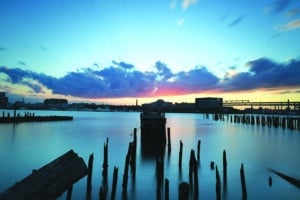
The remains of East Boston wharves at twilight. Mayor Michelle Wu’s administration recently announced it was beginning a process that will lead to formal waterfront zoning changes in the neighborhood.
Boston’s waterfront has become a playground for the rich and powerful, with a bevy of posh new buildings having taken shape on the water’s edge over the past few years in both the Seaport and East Boston as well.
But amid growing angst over the dearth of housing mere mortals can afford, the tide is headed out fast when it comes to plans for new luxury housing along Boston Harbor.
It’s a sea change that can be seen playing out at a couple of high-profile waterfront development sites, as well as in Boston Mayor Michelle Wu’s decision to refocus the city’s planning on neighborhood concerns rather than megaprojects.
Meanwhile, growing concerns about climate change – and sea level rise, in particular – are also raising questions about viability of some waterfront sites for sizable development, let along large luxury condominium or apartment projects.
A Turn Towards Affordable Housing
One of the biggest signs the development tide is shifting can be found out at East Boston’s decrepit Pier 1.
The Massachusetts Port Authority recently released upscale apartment builder Roseland from its lease for the old pier.
The New Jersey developer had talked about building a large residential and hotel complex on Pier 1, but faced sticker shock over the cost of replacing the pilings – $50 million and maybe even more given runaway construction prices – it decided to cancel its plans to expand its Portside at East Pier project, completed in 2014.
But Massport, which, along with operating Logan controls large tracts of harborside acreage in both East and South Boston, isn’t racing to find a new luxury housing developer.
John Nucci, vice president of external affairs at Suffolk University and a Massport board member, is pushing for a project that would involve less dense housing on the pier, with focus on affordability.
“I would like to see something that working families could have a chance of owning,” Nucci said.
Still, given the cost of rebuilding Pier 1, affordable housing would likely be a tough sell for developers, with luxury condos or apartments the likeliest way to recoup those infrastructure costs and turn a profit.
That said, if housing isn’t feasible for one reason or another, Nucci, a lifelong East Boston resident, said he would also be open to green space on Pier 1.
While affordable housing may sound like a stretch given the costs of waterfront development, Massport, in fact, is pushing ahead with plans for a large, affordable high-rise just across the harbor from Eastie in the Seaport district.
Massport is now weighing responses from several developers interested in building affordable housing on a site it controls on D Street, with the potential for an 18-story tower with as many as 200 units.
Wu Moves Away from Megaproject Planning
Meanwhile, the moves by Massport come in the wake of Boston Mayor Michelle Wu’s decision to refocus city’s harbor planning efforts on East Boston’s waterfront.
And the focus will be on anything but more luxury housing. Rather, she wants to look at on “expanding housing options that are affordable, advancing climate preparedness and promoting a healthy environment, transportation connectivity, and supporting neighborhood economies,” city officials noted in a press release.
The change in planning priorities at City Hall, from former Mayor Marty Walsh’s gung-ho approach to development, in turn, may also derail one of the biggest luxury waterfront housing plans still on the table.
In particular, Don Chiofaro’s plans for a $1.2 billion deluxe office-residential tower next to the New England Aquarium and Rowes Wharf, already mired in a years-long, seemingly never-ending vetting process, now faces another round of delays as city planners shift their focus across the water.
Chiofaro’s dream tower does not exactly appear to be a big priority for Wu, to put it mildly. And his project isn’t the only one that could be taking on water.
There are also growing concerns among city officials about the viability of building not just on troublesome Pier 1 in East Boston, but on piers in general amid forecasts of a steep rise in sea levels over the coming decades, an increase that comes after a century in which there was already a pretty significant rise.
The concerns have come to the forefront in the debate over what to do with another problematic development site, Pier 5 in the Charlestown Navy Yard.

Scott Van Voorhis
While supportive of affordable housing on the site, Boston Planning & Development Agency officials said in a recent letter to community members that the cost of rebuilding the pier raises questions about the financial feasibility of any project built there. The agency also notes that “housing on a non-floating pier structure also presents long-term resilience challenges due to sea level rise.”
Nucci, the Massport board member, also notes that any plan to put affordable housing on East Boston’s Pier 1 could face similar challenges.
“I think we have to look at pier development in general as we move forward here,” Nucci said. “There are a lot of risks associated with it and costs.”
Scott Van Voorhis is Banker & Tradesman’s columnist; opinions expressed are his own. He may be reached at sbvanvoorhis@hotmail.com.




 |
| 
